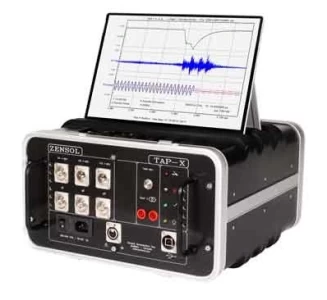Strategies for Accurate Vibro-Acoustic Monitoring of OLTCs

Vibro-acoustic diagnostics have emerged as a rapid and non-invasive method to monitor and assess the health of On Load Tap Changers (OLTCs) in electrical power systems. This technology detects and analyzes the vibrations and sound patterns generated by OLTCs during operation, helping to identify potential issues before they lead to failure. However, accurate vibro-acoustic monitoring faces challenges, notably distinguishing between normal operational noise and signals indicative of a fault, especially in the presence of ambient environmental noise.
Challenges in Vibro-Acoustic Monitoring of OLTCs
Overcoming Ambient Noise
The primary challenge in vibro-acoustic diagnostics of OLTCs is differentiating the sounds of normal functioning from those signaling a problem, amid various ambient noise sources. Industrial environments, where OLTCs are commonly used, are often filled with background noise from machinery, weather, and human activities, which can mask or mimic the acoustic signatures of OLTC anomalies.
Signal Interpretation and Analysis
Another challenge is the interpretation and analysis of vibro-acoustic data. The sounds and vibrations emitted by OLTCs are complex and can be difficult to decode without sophisticated analysis tools and experienced personnel. Accurate diagnosis requires a detailed understanding of the normal acoustic footprint of an OLTC and how it changes under different fault conditions.
Strategies for Overcoming Ambient Noise Challenges
Several strategies can be employed to overcome ambient noise challenges and ensure accurate vibro-acoustic monitoring of OLTCs:
-
Sensor Selection and Placement: Selecting the appropriate sensor type and placement is crucial. Accelerometers with high sensitivity in the relevant frequency range for OLTC diagnostics can help filter out lower frequency background noise. Additionally, strategically mounting the sensors on the OLTC housing, away from other noise sources, can improve signal quality.
-
Advanced Signal Processing Techniques: Modern data acquisition systems utilize sophisticated signal processing techniques to isolate the desired acoustic signatures from the background noise. Filtering algorithms can be employed to selectively attenuate unwanted frequencies while preserving the information-rich signals generated by the OLTC's mechanical operations.
-
Statistical Analysis and Baseline Data: Establishing a baseline vibro-acoustic signature for a healthy OLTC is essential. This baseline can be used as a reference point for subsequent measurements. Statistical analysis techniques can then be applied to identify deviations from the baseline, potentially indicating developing faults within the OLTC.
-
Environmental Monitoring: Continuously monitoring the ambient noise levels can provide valuable insights into potential interference. By correlating changes in noise levels with specific activities or events, technicians can account for these variations during data analysis.
-
Time-Frequency Analysis: Techniques like wavelet transforms can be employed to analyze the vibro-acoustic signal in both the time and frequency domains. This allows for a more comprehensive understanding of the signal characteristics and helps differentiate transient noise events from the characteristic, time-persistent signatures associated with OLTC faults.
Performance and Technical Considerations
Sensitivity and Specificity
The effectiveness of vibro-acoustic diagnostics hinges on the sensitivity of the monitoring equipment to detect subtle changes in sound and vibration, and the specificity to distinguish between normal and abnormal signals. Enhancing both aspects is critical for reducing false positives and negatives in OLTC diagnostics.
Environmental and Operational Factors
The performance of vibro-acoustic monitoring can be influenced by environmental and operational factors, such as temperature fluctuations, humidity, and load variations. Understanding these influences and adjusting the monitoring process accordingly is essential for accurate diagnostics.
Conclusion
Vibro-acoustic diagnostics provide a valuable tool for the fast and efficient monitoring of On Load Tap Changers, enabling early detection of potential issues and preventing costly downtime. Overcoming the challenge of ambient noise and ensuring accurate signal analysis are key to leveraging the full benefits of this technology. With the right strategies and considerations, vibro-acoustic monitoring can significantly enhance the reliability and performance of electrical power systems.

